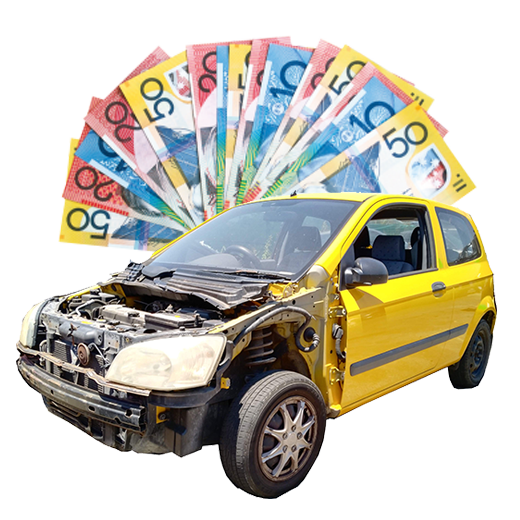So, you’ve just finished an oil change, and now you’re left with a container of old, black motor oil. What's next? The only right answer is to take it to an authorised collection facility. This could be your local council depot or even one of the major auto parts stores that participate in recycling programs.
Whatever you do, never, ever pour it down the drain, into a stormwater sewer, or just tip it out onto the ground. Not only is this illegal, but it causes a shocking amount of environmental damage.
Why Proper Oil Disposal Is Non-Negotiable
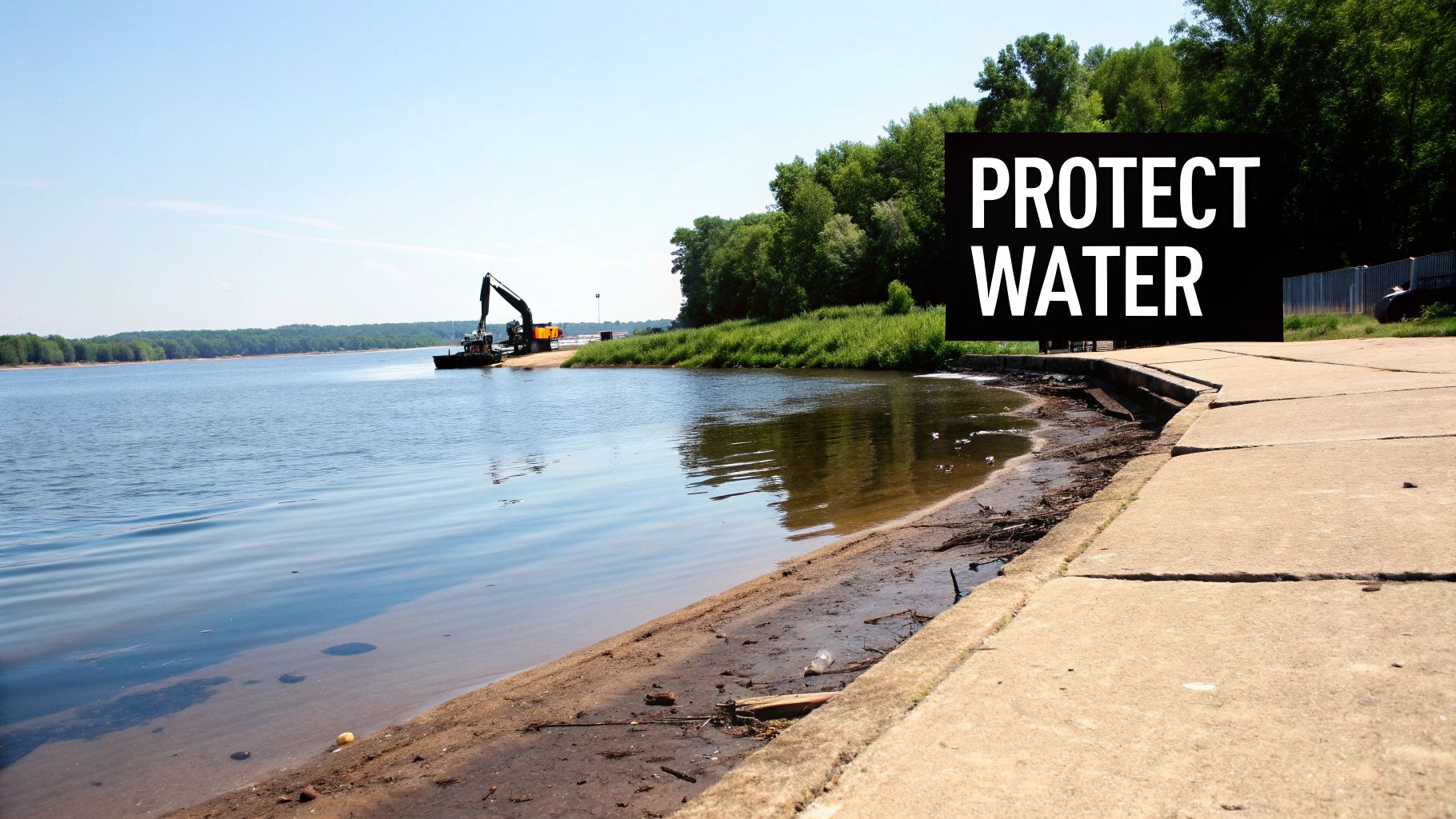
Before we get into the "how," let's really nail down the "why." It's tempting to look for a quick and easy way out, but the fallout from just tipping that oil away is genuinely staggering. That one seemingly small act kicks off a destructive domino effect that hurts our environment, local wildlife, and even our own health.
You see, used motor oil isn't just "dirty." It’s a toxic brew. As it does its job inside an engine, it becomes contaminated with heavy metals like lead, zinc, and arsenic, plus a bunch of other nasty chemicals. When this stuff gets out into the environment, it doesn't just wash away.
The Environmental Toll of Improper Disposal
The damage to our water systems is particularly devastating. Here’s a fact that always stops me in my tracks: just one litre of used motor oil can contaminate up to one million litres of fresh water. Let that sink in. The oil from a single car service can poison a colossal amount of our water.
This contamination creates a mess in a few key ways:
- It Wrecks Aquatic Ecosystems: Oil spreads out to form a thin, suffocating film on the water's surface, which blocks out sunlight and stops oxygen from getting in. This is a death sentence for aquatic plants, fish, and other wildlife.
- It Poisons the Soil: If you dump oil on the ground, it soaks in and basically sterilises the soil, making it infertile. It kills off the helpful microorganisms that keep soil healthy and can stick around as a pollutant for years.
- It Threatens Our Drinking Water: That contaminated groundwater can eventually find its way into the aquifers that supply our drinking water, creating serious health risks for entire communities.
Believe it or not, improperly disposed of oil from cars and workshops is one of the biggest sources of oil pollution in our oceans and rivers—even more than major oil tanker spills. What you do in your driveway has a real, direct impact.
The Legal Consequences in Australia
Aside from the environmental harm, getting caught illegally dumping oil in Australia comes with some hefty legal penalties. Each state's Environmental Protection Agency (EPA) has strict rules, and they don't mess around.
The exact fines change from state to state, but you can expect on-the-spot fines that run from hundreds into thousands of dollars. If you're dealing with larger amounts, especially for commercial operations, the financial penalties can skyrocket, potentially leading to court and even more significant fines. These laws are there for a good reason—to protect the environment we all share. Knowing how to get rid of motor oil the right way is just part of being a responsible vehicle owner.
Your Toolkit for a Clean Oil Transfer
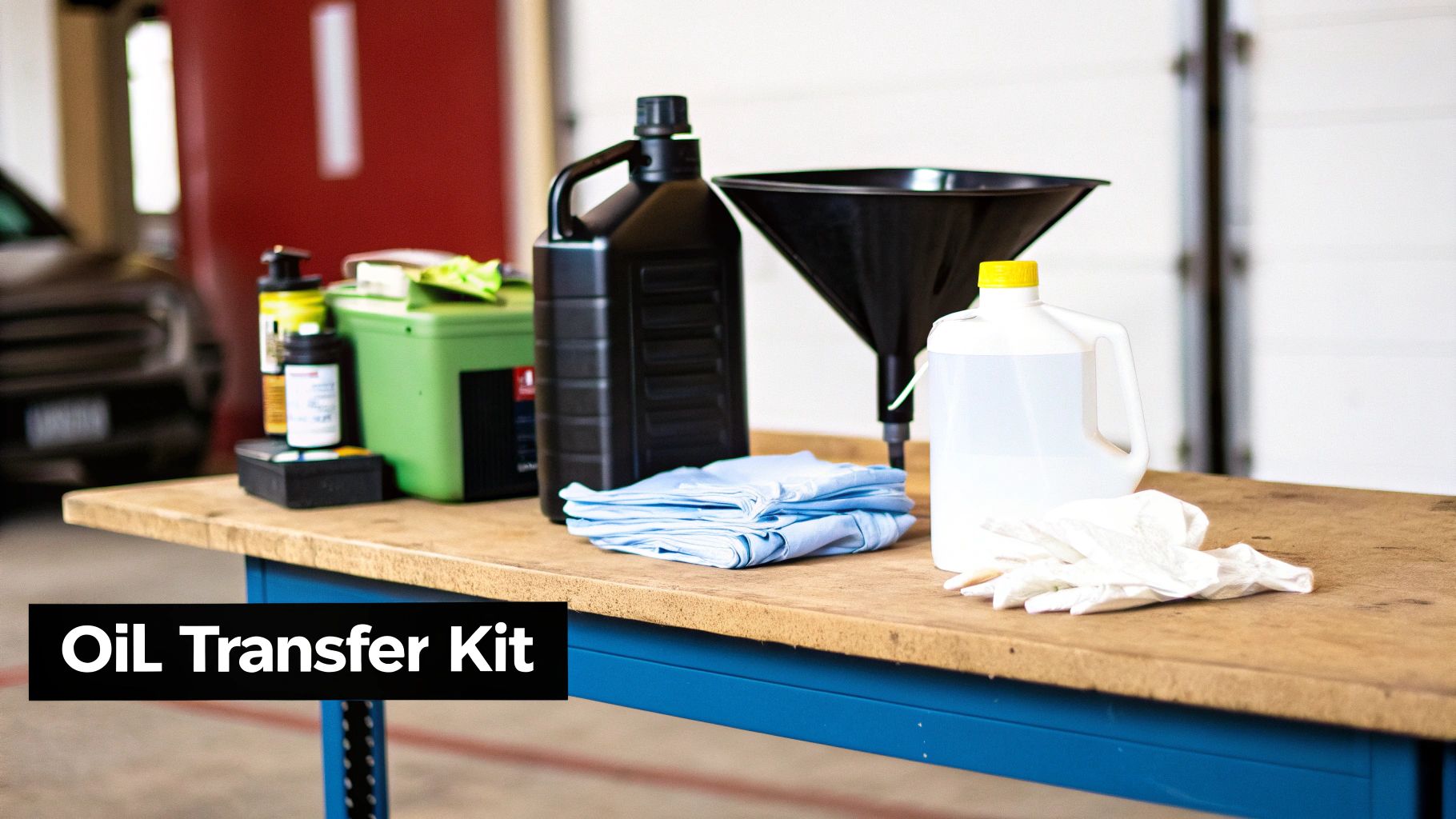
Knowing how to properly discard motor oil starts well before you even think about heading to a recycling centre. A clean, spill-free transfer is all about preparation, and having the right gear on hand makes all the difference. Trust me, trying to wing it is a surefire way to end up with a huge mess on your garage floor and a potential environmental headache.
Think of it like any other DIY project—you get all your tools and materials ready before you start. Gathering everything you need first means you won't be scrambling with oily hands later. It’s the key to making sure every last drop of that used oil ends up exactly where it should.
Choosing the Right Container Is Crucial
First up, you need a solid container. I know it's tempting to just grab an old milk jug or soft drink bottle, but please don't. Those plastics are often too flimsy, can break down when they come into contact with oil, and their lids are never truly secure. One bump in the back of your car and you've got a disastrous leak on your hands.
Your best bet is a purpose-built oil drain pan or, at the very least, a sturdy container with a screw-top lid made from high-density polyethylene (HDPE). That's the same tough plastic your new motor oil comes in. You can pick up specialised oil caddies from any auto parts shop, which often have handy features like built-in funnels. If not, the original bottle your new oil came in is a perfect, no-cost option—just make sure it’s completely empty.
Whatever you use, the most important feature is a secure, leak-proof lid. The whole point is to get the oil from your garage to the disposal point without spilling a drop. A dodgy lid is the number one cause of messes during transport.
The Essential Oil Disposal Toolkit
Getting the container right is a big part of the battle, but a few other items are non-negotiable for a clean job. Having this gear ready will protect you and your driveway, and just generally make the whole process go a lot smoother.
Here’s a quick-reference checklist I use to make sure I’m ready for a clean and spill-free oil transfer.
| Item | Purpose | Pro Tip |
|---|---|---|
| Wide Funnel | Prevents splashes and spills when pouring oil from the drain pan into your transport container. | A funnel with a built-in screen is great for catching the old drain plug if you accidentally drop it. |
| Nitrile Gloves | Protects your skin from the harmful contaminants found in used motor oil. | Keep a box in the garage. They’re useful for all sorts of messy jobs, not just oil changes. |
| Rags or Old Towels | For immediate cleanup of any drips on your tools, the container, or the ground. | Shop towels (the blue paper ones) are highly absorbent and great for this. |
| Cardboard/Drip Pan | Acts as a protective barrier for your garage floor or driveway, catching any unexpected spills. | A large, flattened cardboard box works perfectly and can be recycled afterwards (if it’s not too soaked). |
Once the oil is safely sealed up, do yourself (and the recycling staff) a favour and label the container. A permanent marker and a simple note reading "Used Motor Oil" is all you need to avoid any mix-ups.
For a deeper dive into what happens next, our guide on how to recycle engine oil breaks down the entire journey.
Getting the Old Oil Out and Stored Securely
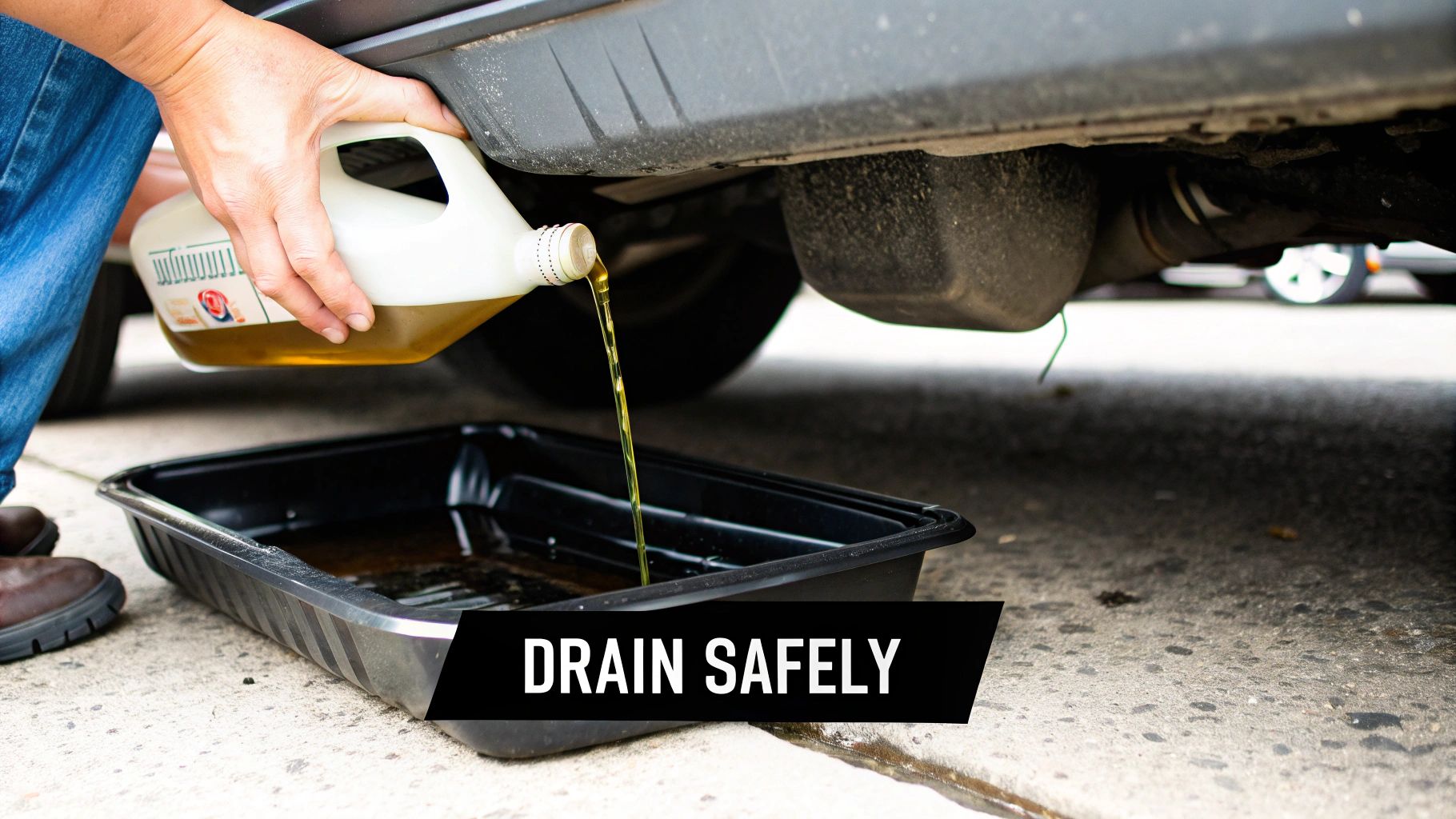
Alright, you've got all your gear, so it's time to get down to business. This is where a little bit of care goes a long way in preventing a greasy disaster on your driveway. Draining engine oil isn't complicated, but one wrong move can leave a permanent stain and cause real environmental harm.
Before you get under the car, start it up and let the engine run for a couple of minutes. The goal is to get the oil warm, not blistering hot. Warm oil is much thinner and flows out quickly, carrying more of the nasty contaminants with it.
Make sure you’re parked on flat, level ground. If the car is on a slope, oil will get trapped in the low corners of the sump, and you won't get a complete drain. It seems obvious, but it’s a crucial step many people overlook.
The Draining Process Unpacked
Once the engine is warm and the car is safely positioned, slide that big sheet of cardboard under the engine bay. Think of it as cheap insurance against drips and spills. Pop your drain pan on the cardboard, right underneath the sump plug.
Now, you need to find that plug. It’s usually a hefty-looking bolt located at the very bottom of the engine's oil pan. Grab the right-sized spanner and turn it anti-clockwise. After you've cracked it loose, I recommend finishing the last few turns by hand (with your gloves on, of course). This gives you better control and stops the plug from falling into a pan full of hot oil—a mistake you only make once.
Get ready for the gush. As you pull the plug away, the oil will come out fast. Just let it flow until it slows to a trickle and finally to a slow drip. Don't rush it. Letting it drain for a good few minutes ensures you get as much of the old gunk out as possible.
A Word of Warning: When you're putting the sump plug back in, it's incredibly easy to overtighten it. This is a classic rookie error that can strip the threads in the oil pan, turning a simple job into a very expensive repair. Just tighten it until it feels snug, then give it a firm quarter-turn with the spanner. That's all it needs.
Don't Forget the Oil Filter
The oil filter is a sneaky one. It can easily hold up to a litre of dirty oil, so you can't just toss it in the bin. You'll probably need an oil filter wrench to get it loose, as they tend to get stuck on there pretty tight.
As you unscrew it, be prepared for more oil to dribble out. Once it’s off, turn the filter upside down over your drain pan and leave it for at least 12 hours to drain completely.
When it’s done dripping, pop the old filter into a sealed plastic bag or an old tub. This will stop any residual oil from making a mess on its way to the recycling centre. The filter needs to be recycled right alongside the used oil.
Bottling It Up for the Road
Now it’s time to transfer the oil. Using your funnel, carefully pour the contents of your drain pan into your dedicated, sealed container. Go slowly to avoid any splashing or that "glugging" effect that always causes a spill.
Screw the lid on as tight as you can. Grab a rag and give the outside of the container a good wipe-down to get rid of any oily residue. Trust me, a clean container is much easier to handle and transport.
Lastly, stash the sealed container and the bagged-up filter somewhere safe where they can't be tipped over. A corner of the garage, away from kids and pets, is perfect. Now you're all set to take it to a proper collection facility.
Locating an Authorised Oil Collection Facility
Alright, you’ve got your used oil safely sealed in a container and the old filter is bagged up. Now for the final, crucial step: getting it to the right place.
Thankfully, Australia has a pretty solid network of authorised collection points, so finding one is often easier than you'd expect. The trick is knowing where to look, because just dropping it off at any old workshop isn't the proper way to do it.
Authorised facilities are set up to handle and process used oil without harming the environment. They have the right storage tanks and are part of a regulated waste stream, making sure every drop gets recycled responsibly.
Your Go-To Digital Resources
The fastest way to find a legitimate drop-off point is right at your fingertips. Instead of driving around town hoping to find a place, a few clicks can give you a list of approved locations nearby.
Here are the best places to start your search online:
- Local Council Websites: This should be your first port of call. Your local council's website will have details on waste management facilities, transfer stations, or depots that accept used motor oil, usually for free.
- State EPA Portals: Each state’s Environmental Protection Authority (EPA) has resources for hazardous waste disposal. Their sites often have databases or maps of collection points.
- RecyclingNearYou: Run by Planet Ark, this is a fantastic nationwide tool. Just pop in your postcode and "motor oil" to see a map of what's close by.
A quick phone call before you head out is always a good idea. You can confirm their opening hours and double-check if there's a limit on how much oil you can bring in at one time.
Understanding the Different Types of Facilities
As you search, you'll see a few different kinds of collection points. Knowing the difference can help you pick the most convenient one. For a more detailed look at your options, take a look at our guide on where to dispose of motor oil.
Many of these places are part of the Product Stewardship for Oil Program, a government initiative that helps fund oil recycling. This is a massive effort, especially when you consider Australia generates hundreds of millions of litres of used oil every year. It’s all part of a growing regional recycling market, which you can read more about in the research on the global waste oil recycling market.
Common collection facilities include:
- Council Depots: These dedicated waste management centres are generally the most reliable bet for the public to drop off used oil.
- Participating Auto Shops: Heaps of major auto parts retailers (think Supercheap Auto or Repco) and some mechanic workshops have collection tanks on-site specifically for DIY mechanics.
- Service Stations: A number of petrol stations also take part in collection schemes, which can be a super convenient option when you're filling up the tank.
Finding the right place to get rid of your old motor oil is a simple but vital part of the job. Taking a few minutes to locate an authorised facility means your hard work pays off by protecting our local waterways and soil. It’s the final step in a job well done.
Common Oil Disposal Mistakes and How to Avoid Them
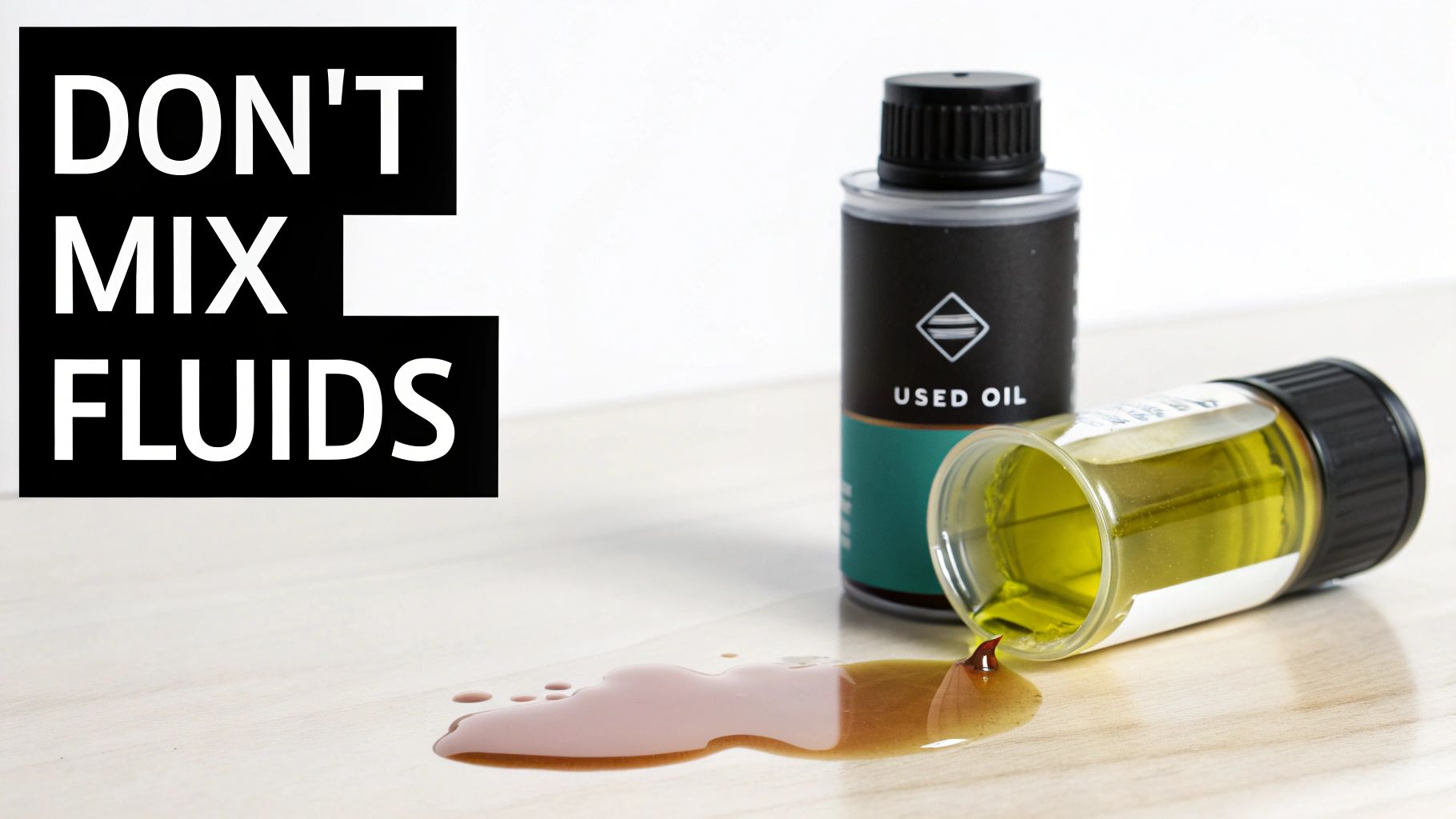
Even with the best intentions, it's surprisingly easy to get motor oil disposal wrong. A few simple slip-ups can turn your good deed into an unrecyclable mess, contaminating entire batches at the collection centre.
Knowing what not to do is just as crucial as following the right steps. Let's walk through the common traps people fall into and how you can steer clear of them.
Never Mix Your Fluids
This is the big one. It’s tempting to use your old oil container as a catch-all for every fluid you drain from your car, but you absolutely can't. Never mix motor oil with other liquids like antifreeze, coolant, transmission fluid, or brake fluid.
Recycling centres use a specific process to re-refine petroleum-based oil. When other chemicals are introduced, the whole batch gets contaminated. Staff at the facility have no choice but to reject it and process it as hazardous waste—a far more expensive and complex headache for everyone.
- The right approach: Get into the habit of using separate, clearly labelled containers for each fluid. If you've drained your coolant, keep it in its own sealed container until you find a facility that specifically accepts it.
Avoid Using the Wrong Container
I know we've mentioned this before, but it's a mistake I see all the time. Reaching for a flimsy milk jug, soft drink bottle, or anything without a tight-sealing lid is a recipe for disaster. These containers simply aren't designed to hold oil; they can split, degrade, or leak, especially during a bumpy car ride.
Also, be sure not to fill your container to the brim. Oil expands with heat, so leaving a bit of air at the top prevents pressure from building up and forcing a leak. A good rule of thumb is to fill it to about 90% capacity.
A leaking container is more than just a greasy mess in your boot. It’s a genuine safety hazard. Oil spills are tough to clean and can even pose a fire risk. Always, always double-check your lid is screwed on tight before you move the container.
Don't Abandon Your Oil After Hours
We've all been there. You load up the car, drive to the local collection point, and find the gates locked. It's frustrating, and the thought of just leaving your container by the fence can be tempting. Don't do it.
This is technically illegal dumping, and it causes huge problems. An abandoned container can be knocked over by an animal, tampered with, or leak after sitting in the sun. It creates a local spill that pollutes the area and forces the facility staff to spend time and resources on a clean-up.
Our guide on how do you dispose of motor oil goes into more detail on the whole process.
- The right approach: Before you even leave the house, make a quick phone call or check the facility's website for their operating hours. If you get there and it's closed, just take the oil back home and try again another day. It's a minor inconvenience that prevents a major environmental issue.
Got Questions About Oil Disposal? We've Got Answers
Even with the best instructions, a few lingering questions always seem to surface, especially if you're new to changing your own oil. Let’s tackle some of the most common ones I hear, so you can handle your used oil with total confidence.
What’s This Going to Cost Me?
Great news on this front. Dropping off your used motor oil is almost always free for household amounts. Most collection points across Australia—think council depots and auto shops like Supercheap Auto or Repco—will happily take up to 20 litres off your hands at no charge.
This is possible thanks to the government's Product Stewardship for Oil Program, which funds the responsible collection and recycling of waste oil. That said, it never hurts to give them a quick call before you head over, particularly if you have a bit more than the standard amount. They can confirm their limits and hours.
Can I Just Let It Sit in the Garage Forever?
I get the temptation. You finish the job, seal the container, and tuck it away on a shelf. Out of sight, out of mind, right? But this isn't a great long-term plan. Over time, plastic containers can become brittle, lids can warp, and the chance of a leaky, messy surprise goes way up. While the oil itself doesn't become more dangerous, it does turn into a needless hazard in your home.
My advice? Make the drop-off part of the oil change ritual. Drain the old oil, bottle it up securely, and aim to recycle it within the next week or two. It keeps your garage clean and eliminates the risk of a spill you'll regret later.
What Should I Do with the Empty Plastic Oil Bottles?
Ah, the tricky part. The plastic bottle your new oil came in is usually made from HDPE (high-density polyethylene), a very recyclable material. The catch? As soon as it's held oil, it's considered contaminated, and most local councils won't let you just toss it in your kerbside recycling bin.
So, what's the right move? Your local council's waste guide is your best friend here. Some will have specific instructions, which often look something like this:
- Let the bottle drain upside down for at least 24 hours to get every last drop out.
- Give the outside a good wipe to remove any greasy residue.
- Leave the cap off so collection staff can easily see it's empty.
In other areas, you might be asked to bring the empty bottles to the same depot where you drop off your used oil. The golden rule is to never assume it can go in your yellow-lidded bin.
Is It Okay to Mix Different Kinds of Motor Oil?
Absolutely. If you've got a bit of leftover synthetic from your car and some conventional oil from the lawnmower, feel free to pour them into the same container for recycling. The re-refining process is sophisticated enough to handle a mix of different petroleum-based engine oils.
What you absolutely cannot do is mix in other fluids. This is the point I can't stress enough. Never, ever add things like coolant, brake fluid, power steering fluid, or solvents to your waste oil. Contaminating it with these substances can ruin the entire batch, making it impossible to recycle. Keep it simple: oil with oil, and nothing else.
Frequently Asked Questions
Still have a few things on your mind? Here’s a quick rundown of some other common queries we get about getting rid of old motor oil.
| Question | Answer |
|---|---|
| How much oil can I drop off at once? | For household quantities, the general limit is 20 litres per drop-off. For larger amounts, you may need to contact a commercial waste oil collector. |
| What happens to the recycled oil? | It gets re-refined into new lubricating oils or processed into fuel for industrial burners, giving it a second life and reducing the need for virgin crude oil. |
| Can I pour oil down the drain? | Never. It's illegal and causes severe environmental damage. Just one litre of oil can contaminate up to one million litres of water. |
| My container is a bit leaky. What should I do? | Place the leaking container inside a larger, sturdier bucket or tub to prevent spills during transport. Make sure to inform the staff at the drop-off point. |
Hopefully, this clears things up and makes your next oil change a smooth, responsible process from start to finish.
Is your old car finally due for its last oil change? Don’t let it rust away in your driveway. Auto Removal Adelaide pays top cash for unwanted vehicles and offers free, hassle-free car removal throughout Adelaide. Turn that old car into cash today—learn more at autoremovaladelaide.com.au.

